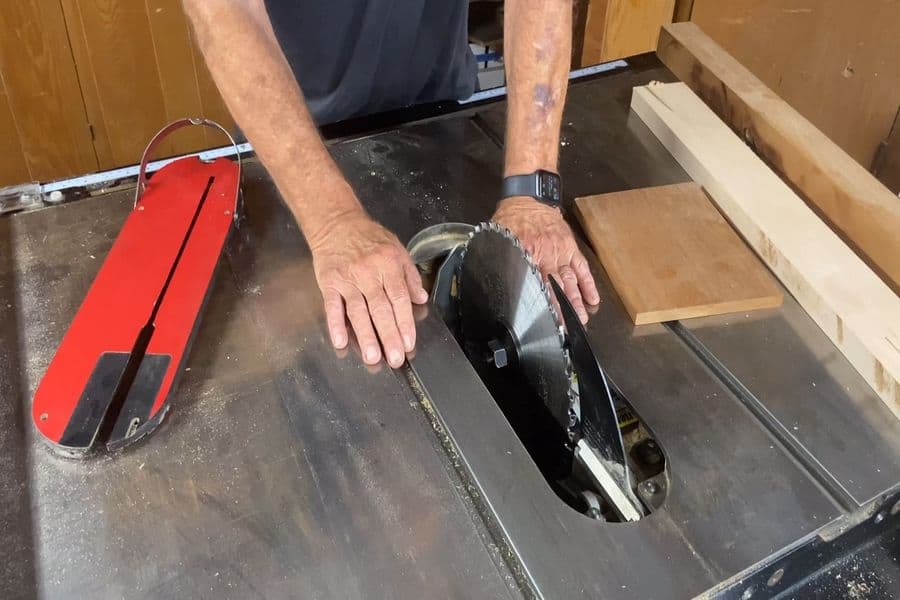Raised panel doors consist of a frame with slots lining its inside and a panel that fits into those slots. A bevel cut is used to ensure the edges of the panel are thin enough to slide easily into place; this process is responsible for the raised pattern of the door.
Table saws have a tilting blade, making them ideal for cutting bevels. We’ll not only explain how to accurately measure and mark your panel for cutting, but also how to precisely adjust your table saw to get the results you want.
Using a Table Saw to Make Raised Panel Doors
While some projects require large table saws or special blades, raised door panels can be made on table saws of any size, using a plain old combination blade.
- Extend your rip fence. Stability of the workpiece is an important factor in avoiding table saw accidents. This technique involves running the workpiece vertically over the saw blade. The short rip fence that came with your table saw won’t provide the stability you need. Use rip clamps to attach a piece of scrap plywood to the fence, or build your own extended rip fence. The extended fence should be about eight inches high.
- Determine the length and width of your panel. Use a rail and stile bit set and a router table to make a mock-up of your door frame, complete with panel slots. To determine the length of your panel, measure the distance between the bottoms of the slots on the upper and lower pieces of the frame. For the width, measure the distance between the bottoms of the two slots on the left and right of the frame.
- Make the panel. Glue straight boards together and plane them to ⅝ of an inch thick. Cut them to the measurements you took in step two, subtracting ⅛ of an inch from the width to allow room for expansion and contraction of the wood.

- Measure and mark the field. Most raised panel doors have a bevel between 1½ and 2 inches wide. Use a combination square to transfer the layout of the pattern you’ve chosen onto the face of the panel.
- Cut the shoulders of the bevel. Raise the combination blade about ⅛ of an inch above the surface of your table. Lock the fence in place after adjusting it so that the blade is aligned at the outer edge of your layout lines, and make the first cut. You will make four cuts during this step, one along each layout line. Use push blocks or sticks to press the workpiece firmly against both the fence and the table while cutting.
- Set the angles of the bevel. Hold a piece of the frame up to the edge or end of the panel, aligning the back of the slot with the back of the panel. Mark the width of the slot on the edge or end of the workpiece. Draw a diagonal line on the edge or end from the layout lines on the face of the panel to the mark you just made. Set and lock a bevel gauge to the angle of that line. You can also use a digital angle gauge for precise results.
- Adjust your blade angle. Raise the saw blade to full height. Place the bevel gauge stock on your table saw next to the saw blade. Tilt the saw blade using the wheel under the tabletop. Stop when the blade of the saw is flush with the blade of the bevel gauge.
- Adjust your blade height. Place the panel against your extended rip fence with the top face toward the blade. Lower the blade into the table until it’s top teeth are just barely at the height of the shoulder you cut in step 6.
- Adjust the rip fence. Press the back of the panel into the fence. Adjust the rip fence until the inner edge of the blade is aligned with the diagonal line you drew in step 7.
- Clamp the workpiece. Rest a scrap piece of wood on top of the fence, and clamp the panel to the scrap. When you are ready to make the cuts, rather than holding onto the panel itself, you will push the piece of scrap along the fence. Clamping the panel to a piece of scrap that rides on the fence helps prevent shifting during the cutting process.

- Attach a featherboard. Applying consistent, even pressure close to the cut site is essential for producing clean, symmetrical raised door panels. The best featherboards for a table saw have semi-flexible ‘fingers’ that press the workpiece into the fence. They are a safe way to apply the correct amount of pressure in just the right place without risking your fingers. If you don’t already own one, you can make a featherboard from a cheap plastic cutting board.
- Make the cuts. Once the panel is clamped to the scrap and the featherboard is in place, turn the table saw on. Use the scrap to guide the panel along the rip fence and over the saw. Turn the panel 90 degrees, reclamp it, and make the second cut. Repeat this process for the remaining two cuts. Turn off the table saw.
- Use a block plane to clean up the panel. Remove burn marks or blade swirls. Smooth the bevels. If necessary, plane the edge of the bevels so they can fit smoothly into the door frame slots. One danger to avoid: hand planing end grain often leads to tearout. To get around this, clamp a sacrificial board to the workpiece. Make sure that the edges are flush. This board will support the edge of the panel and help prevent tearout.
You’ll need to have a table saw that can make these types of cuts.
Conclusion
A table saw with an extended fence and a combination blade can be used to make raised door panels. Make a mock-up of the door frame and use it to determine the size of your panel. Mark the desired width of the bevel on the face of the panel.
On the edges and ends of the panel, mark the maximum thickness possible, dictated by the width of the slots the panel will be resting in. Draw a diagonal line from the first mark to the second. Cut the bevel shoulders into the face of the panel using a ⅛ inch raised combination blade.
Securely position the panel to slide along the fence using a piece of scrap wood, clamps, and featherboard. Cut the bevels, stopping to reorient and reclamp the panel between each cut. Finish the panel with a block plane and assemble the raised panel door.


![Best Battery Powered Chainsaw Reviews – [2023 Buyer Guide] 6 Best Battery Powered Chainsaw Reviews – [2023 Buyer Guide] Best Battery Chainsaw](https://brandisawyer.com/wp-content/uploads/2020/06/best-battery-chainsaw.jpg)
